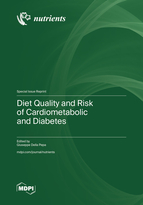Diet Quality and Risk of Cardiometabolic and Diabetes
A special issue of Nutrients (ISSN 2072-6643). This special issue belongs to the section "Nutrition and Diabetes".
Deadline for manuscript submissions: closed (27 June 2023) | Viewed by 27078
Special Issue Editor
2. Department of Clinical Medicine and Surgery, University of Naples Federico II, 80131 Naples, Italy
Interests: dietary intervention; type 2 diabetes; dyslipidaemia; metabolic syndrome; NAFLD
Special Issues, Collections and Topics in MDPI journals
Special Issue Information
Dear Colleagues,
Cardiometabolic risk factors and type 2 diabetes are the largest contributors to the global disease burden and for disease-related mortality. Visceral obesity drives the progression of multiple cardiometabolic risk factors and type 2 diabetes, and behavioural lifestyle weight loss interventions are important strategies for the prevention of these metabolic alterations.
Despite the consistent evidence that the larger the body weight loss, the greater the preventive effect on cardiometabolic risk factors or diabetes, too radical strategies might be unfeasible on a large scale and the long-term maintenance of weight reduction following restricted calorie diets represents a major challenge.
Changes in diet composition acting on nutrient quality, independently of changes in energy intake, may be effective on cardiometabolic and diabetes risk prevention, offering a more feasible and safe alternative treatment to energy restriction.
The aim of the present Special Issue is to summarize recent evidence on “Diet Quality and Risk of Cardiometabolic and Diabetes”. More specifically, the impact of diet quality in terms of micro or macronutrient composition, beyond the effect on diet restriction, on the prevention of cardiometabolic and diabetes risk, as well as diabetes management, will be discussed. Personalized quality dietary interventions for cardiometabolic health and diabetes prevention, as well as possible underlying mechanisms, will also be addressed in this Special Issue.
This Special Issue welcomes submissions of original research and reviews of the scientific literature, including systematic reviews and meta-analyses.
Dr. Giuseppe Della Pepa
Guest Editor
Manuscript Submission Information
Manuscripts should be submitted online at www.mdpi.com by registering and logging in to this website. Once you are registered, click here to go to the submission form. Manuscripts can be submitted until the deadline. All submissions that pass pre-check are peer-reviewed. Accepted papers will be published continuously in the journal (as soon as accepted) and will be listed together on the special issue website. Research articles, review articles as well as short communications are invited. For planned papers, a title and short abstract (about 100 words) can be sent to the Editorial Office for announcement on this website.
Submitted manuscripts should not have been published previously, nor be under consideration for publication elsewhere (except conference proceedings papers). All manuscripts are thoroughly refereed through a single-blind peer-review process. A guide for authors and other relevant information for submission of manuscripts is available on the Instructions for Authors page. Nutrients is an international peer-reviewed open access semimonthly journal published by MDPI.
Please visit the Instructions for Authors page before submitting a manuscript. The Article Processing Charge (APC) for publication in this open access journal is 2900 CHF (Swiss Francs). Submitted papers should be well formatted and use good English. Authors may use MDPI's English editing service prior to publication or during author revisions.
Keywords
- isocaloric diet
- dietary quality
- macronutrient/micronutrient composition
- dietary intervention
- visceral fat
- cardiometabolic risk
- insulin resistance
- hypertension
- dyslipidaemia
- cardiovascular diseases
- endothelial function
- type 2 diabetes
- metabolic syndrome







